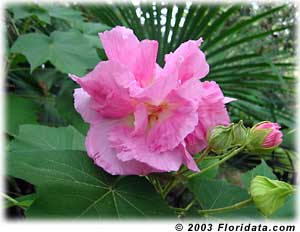 |
|
|
Confederate
Rose
General Botany
Experiment - Spring 04 |
|
Written by: Calah Odom & Christian Bishop,
Biology Majors
Directed by: Thomas H. Wilson,
Professor
Webspinner html by T. H.
Wilson |
| |
| The Confederate Rose, Hibiscus
mutabilis, originated in China, but it has found a new home at Judson College.
This hot weather hibiscus is closely related to cotton and okra. The
Confederate Rose is a large shrub that can reach heights of fifteen feet and
widths of ten feet. Leaves are five to seven inches. The double flowers are
four to six inches in diameter. |
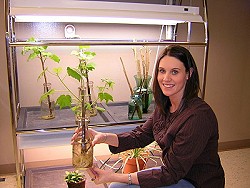 |
|
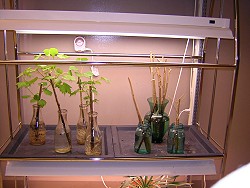 |
The coloration of the flowers of the Confederate
Rose is unusual. The flowers initially bloom white. On the second day, the
flowers become a rose-pink. By the third day, the bloom develops a blue-pink
tone. This Hibiscus is very low maintenance. The plant grows well in full
sunlight or partial, shifting shade. It thrives with regular watering, but is
also fairly drought tolerant. Rich soil with good drainage is essential to
successfully growing this plant. Confederate Roses planted above the Alabama
Fall Line require extra care. During winter, the plants should be covered to
prevent damage from cold temperatures. |
|
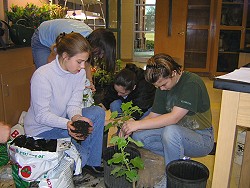 |
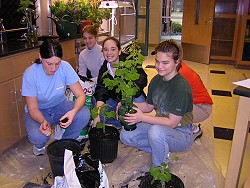 |
| |
|
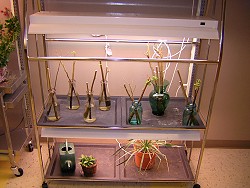 |
The 2004 Botany class is conducting
a Confederate Rose project. This study goes beyond simply growing and nurturing
plants, and several experiments have been designed around this venture. All of
the Confederate Roses are being cultivated from cuttings of about twelve to
fifteen inches taken prior to the first frost of 2003. After the cuttings were
taken, fifty were planted and covered with pine straw. |
| . Twenty-five cuttings were placed in
antique glass jars. These cuttings were placed under artificial sunlight in the
Biology laboratory. The amount of light each plant received was restricted to
eight hours per day. After eight weeks, these plants were transferred to pots
filled with potting soil. The other twenty-five plants were placed in water in
a five gallon bucket and stored in a dark basement until proper planting time.
|
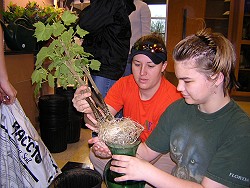 |
| |
|
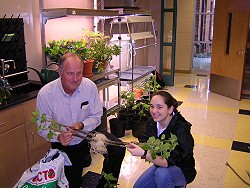 |
The cuttings placed under grow
lights in the laboratory grew and developed at a remarkable rate, while the
cuttings placed in the basement showed no signs of growth. These methods
allowed the students to observe the effects of light on the developing plants.
|
| On the second day of Alabama's newly
commissioned Confederate History Month, April 2, 2004, sixteen of the cuttings
were planted along the Riddle Beach fence behind Judson's gymnasium. Each
Confederate Rose was planted in a mixture consisting of two-thirds potting soil
and one-third organic top soil. After watering, each plant was mulched with
pine straw. The pine straw will improve water retention, weed prevention, and
aesthetic value. |
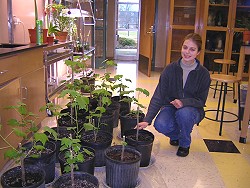 |
| |
|
| |
|
 |
Brian Clements and Calah Odom
worked as a team to ensure the proper planting of the Confederate roses. The
poor construction grade soil was ammended with topsoil and potting mix. |
| |
|
| Rikki Morrison, Whitney Green,
Elizabeth Blackwell, Calah Odom, Caroline Price and Brian Clements planted the
"roses" in time for J-Day, 2004. |
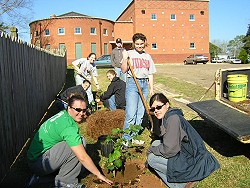 |
| |
|
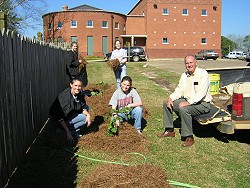 |
Dr. Wilson enjoyed giving planting
instructions from the tailgate of his work truck. It will be fun to watch the
plants grow and produce their first blooms in late summer. |
|
For more information check out this link:
http://www.floridata.com/ref/h/hibis_mu.cfm
|
|
| |
|
 Webspinner Table of Contents Webspinner Table of Contents |
|